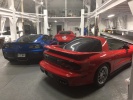
Originally Posted by
Ben Charles

Figured this out some and it was Pure Accident. Idle timing of course as well as most things in the ECU are controlled by Tq. I increased my Tq coefficient tables roughly 10% and noticed Tq management spark at idle was not as aggressive. I looked back at some logs and notice Max Engine tq around 330 at idle, timing around 12-16 degrees (15-20 degrees removed for Tq management spark). With the above change max engine Tq is 385 at idle, timing is 20-23 degrees (8-10 degrees removed for Tq Management spark)
Something else I noticed was cruising at 70 mph Max engine Tq was 365 roughly and now with the above changes its 425.
From the E78 tuning guide
I always had trouble making Max engine Tq higher than predicted other than light throttle or idle, now with changes like above I can get Max higher than predicted ALL THE TIME.
For what its worth the A8 transmission shifts Noticeably BETTER.






 Reply With Quote
Reply With Quote